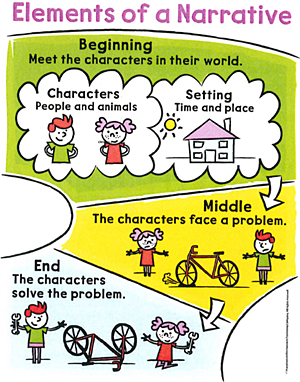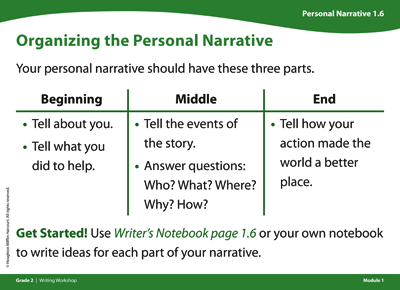Essay: Drafting (Part 1)
Essay: Drafting (Part 1)

This is a graded assignment.
- You will begin writing your rough draft today (Day 4).
- You will turn in the rough draft on Day 5.
In this Module, you will write an imaginative story, which is one type of narrative.
When you draft, you will
- write your ideas,
- draw pictures if you need to, and
- add details.

Part 1: Story Structure
During the drafting phase of the writing process, your main goal is to get all your ideas down on paper and to give those ideas a structure. Use the Personal Narrative Essay (Rough Draft) handout to begin writing your narrative.
Your personal narratives must have a clear beginning, middle, and end.
- Beginning:
- Tell about you.
- Tell what you did to help.
- Middle:
- Tell the events of the story.
- Answer questions: Who? What? Where? Why? How?
- End:
- Tell how your action made the world a better place.
To help write the beginning, middle, and end of the narrative, you may start sentences with
- First, _____.
- Next, _____.
- Then, _____.
- Finally, _____.
- It was a _____ day.
- I was doing _____.
- I thought _____.
- I felt _____.
- I decided to _____ because _____.
Make sure to include details about
- the characters’ actions, thoughts, and feelings; and
- the conflict and resolution.
When I want to add details, I ask myself questions that start with who, what, where, when, why, and how. Questions like “When did I help?” help me add details to my story.
- Is this detail important?
- Is it specific to my story?
- Do my readers need to know this detail to understand my story?
- Is it relevant to my story?
Remember, you generated questions using the “Develop an Idea For Your Narrative” worksheet. These were questions readers may have about the events in your story. As you draft, make sure you include information that answers those questions.
Part 2: Begin Writing the Rough Draft
Use the notes you took in the “Organize Your Personal Narrative” worksheet to help you begin writing. This worksheet will help you organize your ideas from beginning, middle, and end.
You will continue to draft your narrative on Day 5 in Essay: Drafting (Part 2).
Parent/Guardian: As students complete their drafts, take time to check in with them and see if they need help articulating their ideas. Scan their drafts for misspelled words, or mistakes in word order, such as adjectives that appear after a noun instead of before it.
Texas Tech K-12
-
Address
Texas Tech Plaza | 1901 University Ave, Lubbock, TX 79401 -
Phone
(800) 692-6877 -
Email
ttuk12@ttu.edu

